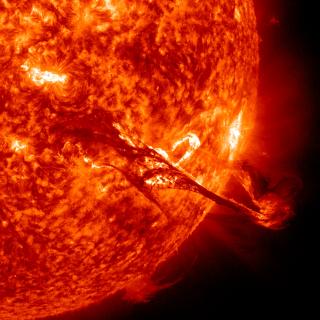Bibcode
Modestov, M.; Khomenko, E.; Vitas, N.; de Vicente, A.; Navarro, A.; González-Morales, P. A.; Collados, M.; Felipe, T.; Martínez-Gómez, D.; Hunana, P.; Luna, M.; Koll Pistarini, M.; Popescu Braileanu, B.; Perdomo García, A.; Liakh, V.; Santamaria, I.; Gomez Miguez, M. M.
Bibliographical reference
Solar Physics
Advertised on:
2
2024
Journal
Citations
18
Refereed citations
16
Description
The MANCHA3D code is a versatile tool for numerical simulations of magnetohydrodynamic (MHD) processes in solar/stellar atmospheres. The code includes nonideal physics derived from plasma partial ionization, a realistic equation of state and radiative transfer, which allows performing high-quality realistic simulations of magnetoconvection, as well as idealized simulations of particular processes, such as wave propagation, instabilities or energetic events. The paper summarizes the equations and methods used in the MANCHA3D (Multifluid (-purpose -physics -dimensional) Advanced Non-ideal MHD Code for High resolution simulations in Astrophysics 3D) code. It also describes its numerical stability and parallel performance and efficiency. The code is based on a finite difference discretization and a memory-saving Runge-Kutta (RK) scheme. It handles nonideal effects through super-time-stepping and Hall diffusion schemes, and takes into account thermal conduction by solving an additional hyperbolic equation for the heat flux. The code is easily configurable to perform different kinds of simulations. Several examples of the code usage are given. It is demonstrated that splitting variables into equilibrium and perturbation parts is essential for simulations of wave propagation in a static background. A perfectly matched layer (PML) boundary condition built into the code greatly facilitates a nonreflective open boundary implementation. Spatial filtering is an important numerical remedy to eliminate grid-size perturbations enhancing the code stability. Parallel performance analysis reveals that the code is strongly memory bound, which is a natural consequence of the numerical techniques used, such as split variables and PML boundary conditions. Both strong and weak scalings show adequate performance up to several thousands of processors (CPUs).
Related projects

Solar and Stellar Magnetism
Magnetic fields are at the base of star formation and stellar structure and evolution. When stars are born, magnetic fields brake the rotation during the collapse of the mollecular cloud. In the end of the life of a star, magnetic fields can play a key role in the form of the strong winds that lead to the last stages of stellar evolution. During
Tobías
Felipe García

Numerical Simulation of Astrophysical Processes
Numerical simulation through complex computer codes has been a fundamental tool in physics and technology research for decades. The rapid growth of computing capabilities, coupled with significant advances in numerical mathematics, has made this branch of research accessible to medium-sized research centers, bridging the gap between theoretical and
Daniel Elías
Nóbrega Siverio